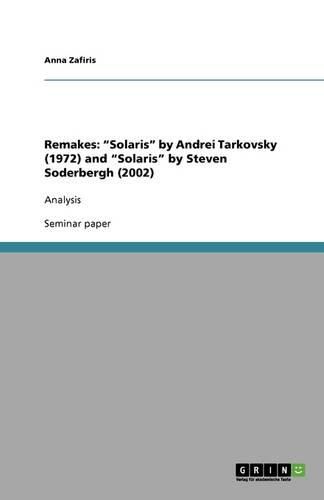Readings Newsletter
Become a Readings Member to make your shopping experience even easier.
Sign in or sign up for free!
You’re not far away from qualifying for FREE standard shipping within Australia
You’ve qualified for FREE standard shipping within Australia
The cart is loading…






This title is printed to order. This book may have been self-published. If so, we cannot guarantee the quality of the content. In the main most books will have gone through the editing process however some may not. We therefore suggest that you be aware of this before ordering this book. If in doubt check either the author or publisher’s details as we are unable to accept any returns unless they are faulty. Please contact us if you have any questions.
Seminar paper from the year 2004 in the subject Communications - Movies and Television, grade: 1, Utrecht University (Media Studies), course: Remakes & Parody, language: English, abstract: Thom Patterson from CNN expresses the issue of the remake in a very nice way: Remaking well-known films can be the Hollywood equivalent of replacing the family dog or a favourite bathrobe: sometimes only the old one will do and a replacement is unthinkable. In my case study I will take a closer look at the two different versions of Solaris : Andrei Tarkovsky’s Solaris (1972) and Steven Soderbergh’s Solaris (2002) Is Soderbergh’s Solaris a worthy representative, replacement or addition to Tarkovsky’s Solaris or is it just like Patterson describes it, unneeded like the replacement of the family dog? Is Tarkovsky’s family dog so well-known and respected that a new family dog would be redundant? First of all, one should notice that both films are based on Stanislaw Lem’s book Solaris . At least that’s what one can read everywhere…but is this so? Is Soderbergh’s film a re-adaptation of Lem’s book or is it rather a remake of Tarkovsky’s film? I would like to analyse in what way the two directors developed the characters in the film having the book Solaris as the basis. By analysing the way, Soderbergh and Tarkovsky present the relationship between Hari/Rheya and Chris and how the two directors develop the characters, I will also try to find an answer to the question whether Soderbergh’s Solaris is a remake of Tarkovsky’s Solaris or a re-adaptation of Lem’s book. What are the similarities and differences of the presentation of this relationship in the two films? Soderbergh for example never personally said that his film is only a remake of Tarkovsky’s Solaris but also, or even more, a re-adaptation of Lem’s book. This would exactly apply to the theory of Jan Speckenbach, who mentions in his first part of On the Remake. A cinematic phenomenon that sometimes the
$9.00 standard shipping within Australia
FREE standard shipping within Australia for orders over $100.00
Express & International shipping calculated at checkout
This title is printed to order. This book may have been self-published. If so, we cannot guarantee the quality of the content. In the main most books will have gone through the editing process however some may not. We therefore suggest that you be aware of this before ordering this book. If in doubt check either the author or publisher’s details as we are unable to accept any returns unless they are faulty. Please contact us if you have any questions.
Seminar paper from the year 2004 in the subject Communications - Movies and Television, grade: 1, Utrecht University (Media Studies), course: Remakes & Parody, language: English, abstract: Thom Patterson from CNN expresses the issue of the remake in a very nice way: Remaking well-known films can be the Hollywood equivalent of replacing the family dog or a favourite bathrobe: sometimes only the old one will do and a replacement is unthinkable. In my case study I will take a closer look at the two different versions of Solaris : Andrei Tarkovsky’s Solaris (1972) and Steven Soderbergh’s Solaris (2002) Is Soderbergh’s Solaris a worthy representative, replacement or addition to Tarkovsky’s Solaris or is it just like Patterson describes it, unneeded like the replacement of the family dog? Is Tarkovsky’s family dog so well-known and respected that a new family dog would be redundant? First of all, one should notice that both films are based on Stanislaw Lem’s book Solaris . At least that’s what one can read everywhere…but is this so? Is Soderbergh’s film a re-adaptation of Lem’s book or is it rather a remake of Tarkovsky’s film? I would like to analyse in what way the two directors developed the characters in the film having the book Solaris as the basis. By analysing the way, Soderbergh and Tarkovsky present the relationship between Hari/Rheya and Chris and how the two directors develop the characters, I will also try to find an answer to the question whether Soderbergh’s Solaris is a remake of Tarkovsky’s Solaris or a re-adaptation of Lem’s book. What are the similarities and differences of the presentation of this relationship in the two films? Soderbergh for example never personally said that his film is only a remake of Tarkovsky’s Solaris but also, or even more, a re-adaptation of Lem’s book. This would exactly apply to the theory of Jan Speckenbach, who mentions in his first part of On the Remake. A cinematic phenomenon that sometimes the